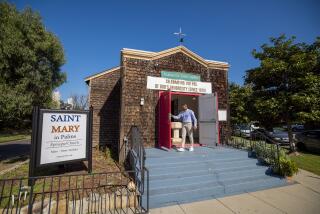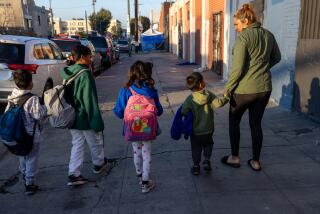CRA Agrees to Pay Mission $6.5 Million to Move Off Main St.
In a move officials say is intended to “upgrade” part of Main Street in downtown Los Angeles, Community Redevelopment Agency commissioners voted Wednesday to pay the Union Rescue Mission $6.5 million to move about five blocks away.
The 98-year-old nondenominational Protestant mission, which houses about 800 homeless men each night, is the oldest and largest mission in the downtown area. About 70 years ago, it was evicted from its original site to make way for City Hall and has been at 226 S. Main St. ever since.
Considered a Blight
Now, the mission has run afoul of city redevelopment plans and is considered a blight by officials who want to refurbish Main Street along with the rest of the downtown business district. The Ronald Reagan State Office Building is under construction only a block away.
“This has been a main target for six years,” CRA Commission Chairman James Wood said of the relocation plan before the commissioners voted 6 to 0 to make the payment for relocation. The matter goes before the City Council within the next two weeks for final action. The payment for the Main Street property would be a separate transaction.
But the move is encountering strong opposition from businessmen near the new location and worries some homeless providers concerned about the effect of a high concentration of homeless services in one area.
The mission is slated to move from its current location next door to St. Vibiana’s Cathedral in the heart of Skid Row to an unused manufacturing building at 547 S. San Pedro St.
George Caywood, Union Rescue Mission’s executive director, said about $6 million of the payment would be used to purchase the property and the remainder for architectural drawings and remodeling. The mission is also trying to raise additional funds on its own to make the new facility even bigger.
“The homeless demand is unreal,” Caywood said. “It’s gotten worse.”
At night, several dozen men sleep on the sidewalks in front of the mission’s three-story building because there is no room for them inside.
The mission does not oppose relocation, Caywood added, “if it helps us serve more people and in a more compassionate way.”
“By relocating them, you are improving the property values, the business climate of one area and damaging another,” said Charles Woo, owner of ABC Toys and chairman of the Central City East Assn., a group of about 50 businesses along Skid Row.
Many of the association members are toy importers and fish processors who have moved into the area, with city encouragement, in the last decade. They consider the alcoholics, mentally ill, drug users and homeless who populate Skid Row as a threat to their efforts to form a viable business center.
They also complain that too many social service programs are already close to the mission’s proposed new location. These include the Weingart Center, a multi-service agency with 600 beds; the Transition House, a live-in rehabilitation program for 130 people, and, the St. Julian emergency shelter, which houses 138 nightly.
The Los Angeles Mission is also building a new complex at 5th and Wall streets to house another 700 people nightly, and L.A. Men’s Place, a program for the mentally ill, is remodeling a building on San Pedro where 50 men and women will live.
“The over-concentration of the homeless is not healthy, and as a businessman in the area I resent being on the short end of the stick,” Woo said.
“I expected there would be opposition,” Commissioner Wood said. “Every single site proposed has been opposed for the same reason.”
“That’s predictable,” Caywood said, “but it kind of sticks in my craw. I don’t know why this city allows discrimination against poor people. Why can they say they don’t want poor people in their neighborhood? The fact is in our country poor people are in three primary categories, blacks, Hispanics and women with children.
“When monied interests are allowed to say, ‘We don’t want homeless people in our neighborhood,’ they are, in effect, being allowed to say, ‘We don’t want women with children,’ ‘We don’t want blacks,’ ‘We don’t want Hispanics.’ It bothers me.”
Mike Neely, head of the Homeless Outreach Program, a CRA-funded agency using former homeless people to help current Skid Row people get off the streets, said there is more need for affordable low-income housing than shelter beds.
“Why not build residences?” he asked. “Why not build a community?”
Marshall Bennett, owner of Mission Engraving on San Pedro Street, questioned whether it was legal for the city to give money to a “sectarian organization.”
But CRA general counsel Murray Kane said because the relocation is part of the city’s formal redevelopment plan, “We are not only authorized to use taxpayer money for relocation, we’re mandated to do so. We cannot deny any relocatee compensation just because they happen to be a religious organization.”
Other CRA officials said the $6.5-million figure was determined on the basis of what it would cost to rebuild the mission’s current 65,000-square-foot facility. CRA and mission officials said the choice of the new site and the amount paid for it were left up to the mission.
The redevelopment agency has also taken an option to purchase the current mission site on Main Street, said CRA Director of Operations Don Spivak, who added that the agency has not determined a use for the land “at this point.” The money paid would be in addition to the $6.5-million relocation payment, he added.
“It’s going to be a better facility,” said Sid Blanchard, a thin, lanky mission resident who also works there as a security guard.
“This is all about money, economics. That’s all it is,” shrugged Ron Clayborn, a thin, neatly dressed man with a stubbled beard, sitting on a trash can. He has been homeless a little more than a year, he said, but was not interested in whether the mission moved or not.
“I don’t care,” he said. “I’m not here for the duration.”
More to Read
Sign up for Essential California
The most important California stories and recommendations in your inbox every morning.
You may occasionally receive promotional content from the Los Angeles Times.










